Fee Fi Foe Film: Rutgers Defense

Previously: Rutgers Offense
in coverage: RU's top-graded player in their back seven.
After looking at the more recent OSU game for the offense post, I switched to Washington for the defense because OSU's and Michigan's offenses are so dissimilar.
It probably didn't matter. Does anything matter?
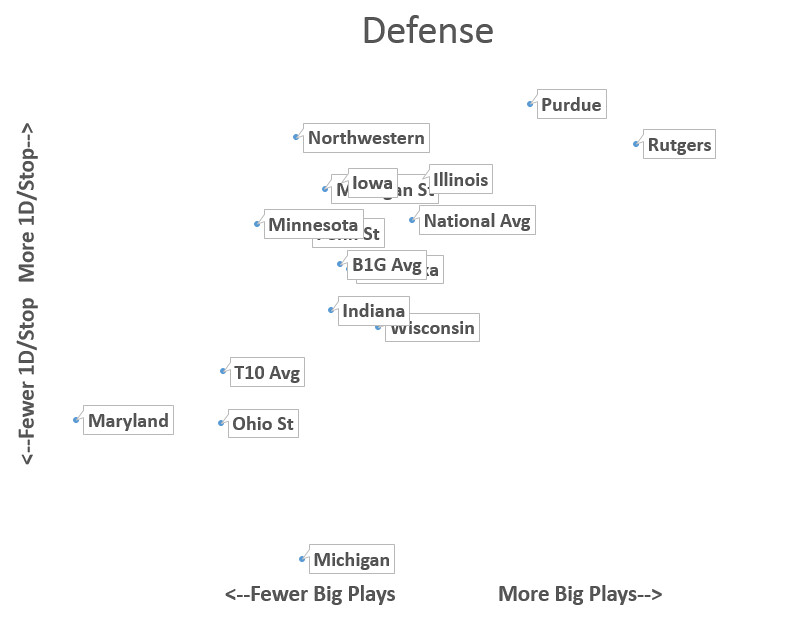
via The Mathlete. bottom left is good, top right is bad.
Nothing matters.
Personnel: Seth's diagram [click to embiggen]:
Rutgers's second-best defensive lineman, DE Quanzell Lambert, was lost for the season in the Iowa game, and SLB Greg Jones suffered a scary injury after a helmet-to-helmet collision against OSU—he's out and may be done playing football. Their season-opening starter at free safety, Saquon Hampton, went down in the Washington game; his replacement, Kiy Hester, got dinged up last week and is questionable for Saturday. Hampton is reportedly ready to return to the lineup this week, so we've penciled him in as the starter.
Base Set? 4-3. Since Rutgers is a heavy quarters team—Chris Ash was OSU's defensive coordinator before coming to RU this year—they don't bring on a nickel as often as many teams; their safeties are responsible for the slot receivers if they go deep, and they'll shade the SLB over the slot to cover underneath stuff.
[Hit THE JUMP for the rest of the breakdown.]
Man or zone coverage? Mostly cover four, which is technically a zone defense but functions more like man press. Ross Fulton's primer from four years ago is still a great read on the concept.
Pressure: GERG or Greg? Rutgers didn't blitz much against UW. Their linebackers are 99th in havoc rate, so this appears to be the usual.
Dangerman: The primary dangerman is DT Darius Hamilton, who's up to a DT-sized 286 pounds as a Brooks Bollinger Memorial 8th-Year Senior Award contender. That added bulk allows him to hold up much better to double-teams than he did as a 260-pound nose a couple years back, and he's still got that lightning-quick first step. While he hasn't piled up stats this year—only one TFL—he's grading out very well on PFF with a +11.3 grade, most of which comes from his ability to stop the run.
That stands out on film. This is a Ryan Glasgow play:
Hamilton doesn't just hold up to a double-team from two OL; he pops out the other side to stop the play cold. He's become a great run defender and he's also dangerous as an interior pass-rusher—he flushed UW's QB out of the pocket a couple times with immediate pressure off the snap. Hamilton is shield-worthy.
The other defender grading out well enough on PFF to merit a star doesn't start for reasons beyond my comprehension. Backup NT Kevin Wilkins has a +7.2 in only 143 snaps; starting NT Sebastian Joseph has a -3.4 in 183 snaps. On one of the few bright-spot plays in the UW game, Hamilton shot a gap to force a cutback and Wilkins stoned a double-team at the line of scrimmage to stop the Huskies on a fourth-and-one deep in RU territory.
OVERVIEW
The stats from this game are deceiving, as Washington put up 24 points in the first quarter, added a kickoff return touchdown in the second, and basically closed up shop—their two second-half scores were on punt and interception returns. While the Huskies were able to throw at will—an even ten yards per attempt—they managed only 100 yards on 28 non-sack carries.
What I saw in the first quarter, however, suggested Rutgers can be run on, and last week's game against Ohio State—admittedly a superior running team to Michigan—drove that home. Rutgers held their own with Hamilton on the field; when he took a breather, there were major issues:
Washington didn't have trouble getting movement up front:
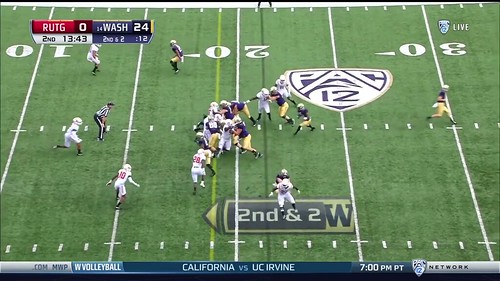
DE Julian Pinnix-Odrick is the next-best guy on the starting D-line; he's #53, the near-side end, in the video above, getting escorted past the play to open up a gaping hole. He's graded out as positive in run defense on PFF and negative in pass-rush, but I'm not seeing it; four of his five TFLs are sacks and his aggressiveness opened up lanes against both the run and pass. He's all about getting upfield, which can occasionally get him the corner on a pass-rush or shooting a gap against the run, but just as often it causes problems. Washington's QB was able to extend a play when Pinnix-Odrick took his rush a good 12 yards deep—we've said here that 7-8 is ideal for keeping contain—and that turned into a first down throw off an easy escape from the pocket.
Hamilton and Wilkins are good interior duo. Joseph can be moved too easily. The non-Wilkins backup DL are not good; DT Jon Bateky and DE Myles Nash should be targeted at the point of attack when they're in the game. Lambert's replacement at DE, Darnell Davis, is grading out decent against the run, but he's not much of a pass-rush threat.
The linebackers had a rough go of it. Too often they get caught up in traffic and can't get to the football—watch the MIKE, Deonte Roberts, on this play:
They're susceptible to overpursuit, as well. This play-action caused them to bite so hard that even after the back catches and turns upfield, only one Rutgers defender—the cornerback getting blocked into the sideline by a wideout—is on the correct side of the hashes:
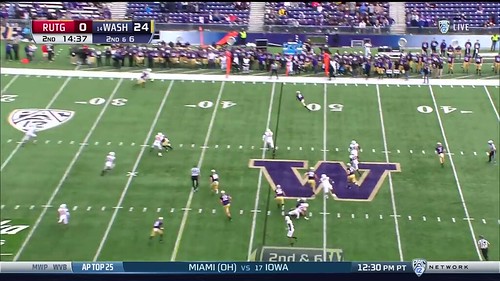
That play, as you'd expect, got a huge chunk before the safeties finally got to the ball.
Speaking of the safeties, Rutgers has a decent SS in Anthony Cioffi, who had a critical PBU on a would-be touchdown throw and a pick after the game was already decided; he's grading out positive against both the run and the pass. He had to make that PBU, however, because FS Saquan Hampton stood flat-footed on play-action and never noticed the receiver running up the seam behind him—he's rooted to the 15-yard line on the far hash:

If Washington's QB got this ball out on time, it was an easy touchdown; he was a beat late and Cioffi got over from his deep zone to knock it away.
Hampton, who's slated to return to the lineup this week, was a major sore spot. The play above should've resulted in a touchdown. This play, on which he was responsible for the slot receiver in RU's staple quarters coverage, did result in a touchdown:
He also took a god-awful angle on a jet sweep that the playside OLB had actually done a good job of potentially turning back inside:
There's pursuit on the way, so Hampton needs to go outside of the OLB and force the cut back upfield. Instead, he kamikazes into the lead blocker at an angle that gives him no shot of reaching the runner even if the lead blocker doesn't exist, and a play that should pick up a few ends up netting a first down and more. This could be a breakout opportunity for Eddie McDoom and/or Kekoa Crawford; I'd like to see M test the edge with jet sweeps and send those guys deep up the seam to test the safeties.
As for the corners, Isaiah Wharton nearly got beat deep for a touchdown—UW overthrew the receiver—only a few plays before he did get beat deep for a touchdown on the play at the top of this post. The other starter, Blessuan Austin, didn't get targeted much from what I saw, but he did have a comically poor tackle attempt to free up the edge on a toss sweep. RU keeps their secondary rotation very tight; nominal nickel Damon Hayes has only played 48 snaps this season.
The defense isn't quite as bad as the offense. That's not a high bar to clear, though. Michigan should be able to push these guys around up front, throw a fair amount of intermediate stuff—Jake Butt could have a big day with Jones, RU's best cover linebacker by some distance, out—and hopefully hit some big plays over the top. This is the game for Wilton Speight to get locked in on deep throws.
PLAY BREAKDOWN
Not actually a play breakdown, but I screencapped a couple things from RU's punts during the OSU game. Dontre Wilson was (rightfully) pissed that he only returned this out to OSU's 43-yard line:
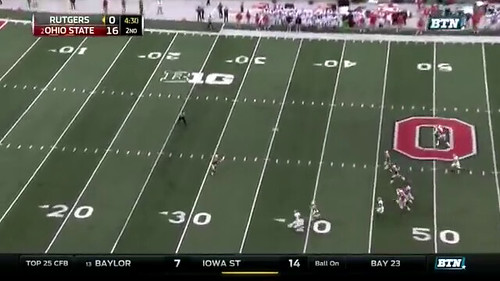
And I have no idea how this wasn't blocked:
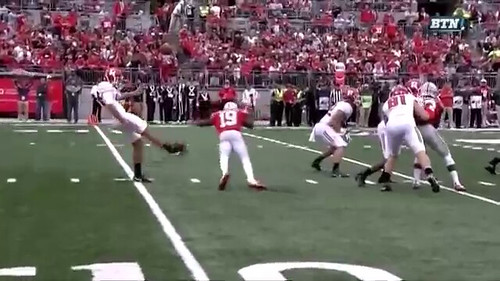
Without Janarion Grant on returns, RU's special teams are awful outside of a decent kicker who probably won't have any impact on the game's outcome. Josh Hicks is averaging 12.8 yards per kickoff return. Jawuan Harris has one punt return for no yards. 23 of their 24 kickoffs have been returned with opponents getting an average start at the 29. Despite averaging only 38.5 yards per punt, punter Michael Cintron has allowed 16 returns (for 142 yards) on 36 punts.
Jabrill Peppers's Heisman campaign is in line to get a huge boost this weekend.
October 6th, 2016 at 5:04 PM ^
Rutgers is my friend
October 6th, 2016 at 7:44 PM ^
Rutgers is going to come talk to you in a year or two about how your friendship is one sided and all you do is take, take, take.
Is that the kind of friend you want to be???
October 6th, 2016 at 5:10 PM ^
Sent from MGoBlog HD for iPhone & iPad
October 6th, 2016 at 5:13 PM ^
He was mentioned as a potential replacement for Hester when Hampton's status was up in the air, but he's only played 13 snaps this year and would be moving from cornerback. Unless Hampton is too far from 100% to play the whole game, he should be the guy—and, as noted, RU doesn't rotate in the secondary much at all.
October 6th, 2016 at 6:26 PM ^
He's been hurt and I think maybe he played a little bit last week, but he's been working his way back.
October 6th, 2016 at 5:13 PM ^
Ace, have you considered the Order of the Bull's Blood?
I understand that they have stuffed animals and magnets.
October 6th, 2016 at 5:14 PM ^
They have no idea they suck.
October 6th, 2016 at 8:53 PM ^
October 6th, 2016 at 11:15 PM ^
Saw the offense FFFF on a Rutgers forum (link). Some amusing comments. I think they know their level of suck.
October 6th, 2016 at 5:52 PM ^
Isn't Kalis #67? Also, not even a star-up for him yet? He's arguably been our top OL all year.
October 6th, 2016 at 7:14 PM ^
Sent from MGoBlog HD for iPhone & iPad
October 6th, 2016 at 6:28 PM ^
October 6th, 2016 at 7:04 PM ^
giving Darboh a shield.
October 6th, 2016 at 8:14 PM ^
Darboh's good. Chesson's good. Butt's good. Hill's good. Cole's good. Smith's good. Kalis is. . . good, and let's hope he stays that way. But against the two teams we've played with a pulse, the only player that has demanded extra attention (opening up other things) has been Butt. Cole can get stoned by legit NTs and neither wideout has consistently burned anyone crispy since Florida. I think the second most consistent player worthy of a star would actually be Smith, since he's an excellent pass blocker, can level fishing villages and lately has been making the right cuts. He's been turning 2 yards into 5 with regularity, which doesn't really scare defenses but eventually demoralizes them.
Otherwise, I think probably the most remarkable aspect of our offense is its chameleon ability. Despite being hippopotamus-shaped it's mimicked spread-to-run, air raid and SLUDGEFART. You can't do that unless players are versatile at every position, so we have that going for us. Go team, but stars and shields are about fearsome individual players and we're kind of lacking in that department.
October 6th, 2016 at 11:12 PM ^
October 7th, 2016 at 12:08 PM ^
I'm pretty sure Khalid Hill has been getting some All American hype from the National Media. He's a dude and deserves a shield. His carry to TD ratio may be helping this too!
October 6th, 2016 at 7:11 PM ^
when crushing Rutgers 58-0.
And there is no way freaking in hell that Jim Harbaugh agrees to shorten on second off a game of manly competition of college footbaugh!
October 6th, 2016 at 10:13 PM ^
October 6th, 2016 at 10:45 PM ^
October 6th, 2016 at 11:01 PM ^
October 6th, 2016 at 11:20 PM ^
It could be for new starters (not just freshmen) as a star inscribed inside the circle, so that you have a contrast between completely empty white circles and stars inside. Although I have to admit I like the way the up and down stars look when combined.
Anyway, these diagrams are great, keep it up!
October 7th, 2016 at 9:43 AM ^
Sent from MGoBlog HD for iPhone & iPad
October 7th, 2016 at 7:56 AM ^
This is probably something everyone who follows stats more than me knows but what does "1D stop" on the vertical axis of the mathletes chart mean. I was thinking "stops" for less than some amount of yards (3?) but less is better.
October 7th, 2016 at 9:04 AM ^
Rutgers has a defence?
Since when?
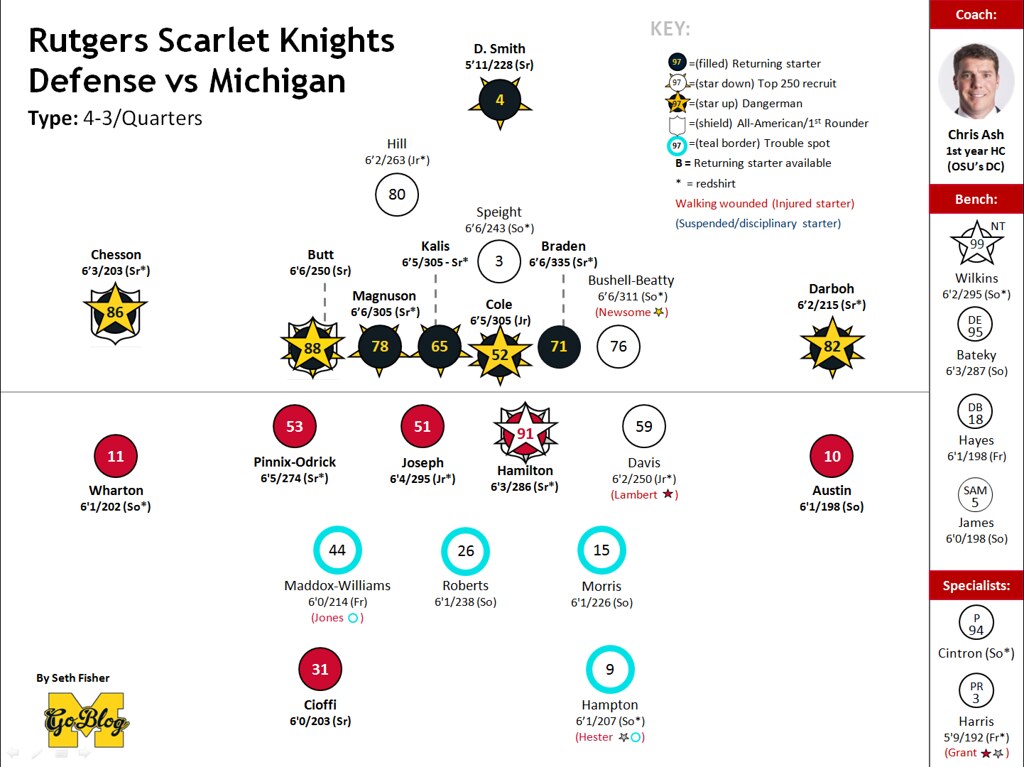
Comments